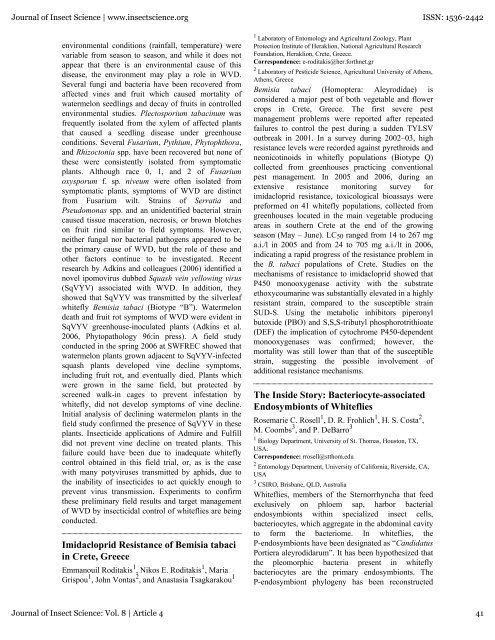Fourth International Bemisia Workshop International Whitefly ...
Fourth International Bemisia Workshop International Whitefly ...
Fourth International Bemisia Workshop International Whitefly ...
You also want an ePaper? Increase the reach of your titles
YUMPU automatically turns print PDFs into web optimized ePapers that Google loves.
Journal of Insect Science | www.insectscience.org ISSN: 1536-2442<br />
environmental conditions (rainfall, temperature) were<br />
variable from season to season, and while it does not<br />
appear that there is an environmental cause of this<br />
disease, the environment may play a role in WVD.<br />
Several fungi and bacteria have been recovered from<br />
affected vines and fruit which caused mortality of<br />
watermelon seedlings and decay of fruits in controlled<br />
environmental studies. Plectosporium tabacinum was<br />
frequently isolated from the xylem of affected plants<br />
that caused a seedling disease under greenhouse<br />
conditions. Several Fusarium, Pythium, Phytophthora,<br />
and Rhizoctonia spp. have been recovered but none of<br />
these were consistently isolated from symptomatic<br />
plants. Although race 0, 1, and 2 of Fusarium<br />
oxysporum f. sp. niveum were often isolated from<br />
symptomatic plants, symptoms of WVD are distinct<br />
from Fusarium wilt. Strains of Serratia and<br />
Pseudomonas spp. and an unidentified bacterial strain<br />
caused tissue maceration, necrosis, or brown blotches<br />
on fruit rind similar to field symptoms. However,<br />
neither fungal nor bacterial pathogens appeared to be<br />
the primary cause of WVD, but the role of these and<br />
other factors continue to be investigated. Recent<br />
research by Adkins and colleagues (2006) identified a<br />
novel ipomovirus dubbed Squash vein yellowing virus<br />
(SqVYV) associated with WVD. In addition, they<br />
showed that SqVYV was transmitted by the silverleaf<br />
whitefly <strong>Bemisia</strong> tabaci (Biotype “B”). Watermelon<br />
death and fruit rot symptoms of WVD were evident in<br />
SqVYV greenhouse-inoculated plants (Adkins et al.<br />
2006, Phytopathology 96:in press). A field study<br />
conducted in the spring 2006 at SWFREC showed that<br />
watermelon plants grown adjacent to SqVYV-infected<br />
squash plants developed vine decline symptoms,<br />
including fruit rot, and eventually died. Plants which<br />
were grown in the same field, but protected by<br />
screened walk-in cages to prevent infestation by<br />
whitefly, did not develop symptoms of vine decline.<br />
Initial analysis of declining watermelon plants in the<br />
field study confirmed the presence of SqVYV in these<br />
plants. Insecticide applications of Admire and Fulfill<br />
did not prevent vine decline on treated plants. This<br />
failure could have been due to inadequate whitefly<br />
control obtained in this field trial, or, as is the case<br />
with many potyviruses transmitted by aphids, due to<br />
the inability of insecticides to act quickly enough to<br />
prevent virus transmission. Experiments to confirm<br />
these preliminary field results and target management<br />
of WVD by insecticidal control of whiteflies are being<br />
conducted.<br />
Imidacloprid Resistance of <strong>Bemisia</strong> tabaci<br />
in Crete, Greece<br />
Emmanouil Roditakis 1 , Nikos E. Roditakis 1 , Maria<br />
Grispou 1 , John Vontas 2 , and Anastasia Tsagkarakou 1<br />
1 Laboratory of Entomology and Agricultural Zoology, Plant<br />
Protection Institute of Heraklion, National Agricultural Research<br />
Foundation, Heraklion, Crete, Greece.<br />
Correspondence: e-roditakis@her.forthnet.gr<br />
2 Laboratory of Pesticide Science, Agricultural University of Athens,<br />
Athens, Greece<br />
<strong>Bemisia</strong> tabaci (Homoptera: Aleyrodidae) is<br />
considered a major pest of both vegetable and flower<br />
crops in Crete, Greece. The first severe pest<br />
management problems were reported after repeated<br />
failures to control the pest during a sudden TYLSV<br />
outbreak in 2001. In a survey during 2002–03, high<br />
resistance levels were recorded against pyrethroids and<br />
neonicotinoids in whitefly populations (Biotype Q)<br />
collected from greenhouses practicing conventional<br />
pest management. In 2005 and 2006, during an<br />
extensive resistance monitoring survey for<br />
imidacloprid resistance, toxicological bioassays were<br />
preformed on 41 whitefly populations, collected from<br />
greenhouses located in the main vegetable producing<br />
areas in southern Crete at the end of the growing<br />
season (May – June). LC 50 ranged from 14 to 267 mg<br />
a.i./l in 2005 and from 24 to 705 mg a.i./lt in 2006,<br />
indicating a rapid progress of the resistance problem in<br />
the B. tabaci populations of Crete. Studies on the<br />
mechanisms of resistance to imidacloprid showed that<br />
P450 monooxygenase activity with the substrate<br />
ethoxycoumarine was substantially elevated in a highly<br />
resistant strain, compared to the susceptible strain<br />
SUD-S. Using the metabolic inhibitors piperonyl<br />
butoxide (PBO) and S,S,S-tributyl phosphorotrithioate<br />
(DEF) the implication of cytochrome P450-dependent<br />
monooxygenases was confirmed; however, the<br />
mortality was still lower than that of the susceptible<br />
strain, suggesting the possible involvement of<br />
additional resistance mechanisms.<br />
The Inside Story: Bacteriocyte-associated<br />
Endosymbionts of Whiteflies<br />
Rosemarie C. Rosell 1 , D. R. Frohlich 1 , H. S. Costa 2 ,<br />
M. Coombs 3 , and P. DeBarro 3<br />
1 Biology Department, University of St. Thomas, Houston, TX,<br />
USA.<br />
Correspondence: rrosell@stthom.edu<br />
2 Entomology Department, University of California, Riverside, CA,<br />
USA<br />
3 CSIRO, Brisbane, QLD, Australia<br />
Whiteflies, members of the Sternorrhyncha that feed<br />
exclusively on phloem sap, harbor bacterial<br />
endosymbionts within specialized insect cells,<br />
bacteriocytes, which aggregate in the abdominal cavity<br />
to form the bacteriome. In whiteflies, the<br />
P-endosymbionts have been designated as “Candidatus<br />
Portiera aleyrodidarum”. It has been hypothesized that<br />
the pleomorphic bacteria present in whitefly<br />
bacteriocytes are the primary endosymbionts. The<br />
P-endosymbiont phylogeny has been reconstructed<br />
Journal of Insect Science: Vol. 8 | Article 4 41
















